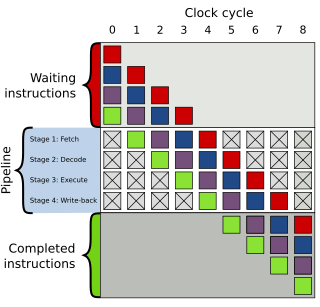
Hidden Markov Model (HMM) is a statistical Markov model in which the system being modeled is assumed to be a Markov process with unobserved states.

A Bayesian network, Bayes network, belief network, decision network, Bayes(ian) model or probabilistic directed acyclic graphical model is a probabilistic graphical model that represents a set of variables and their conditional dependencies via a directed acyclic graph (DAG). Bayesian networks are ideal for taking an event that occurred and predicting the likelihood that any one of several possible known causes was the contributing factor. For example, a Bayesian network could represent the probabilistic relationships between diseases and symptoms. Given symptoms, the network can be used to compute the probabilities of the presence of various diseases.

A decision tree is a decision support tool that uses a tree-like model of decisions and their possible consequences, including chance event outcomes, resource costs, and utility. It is one way to display an algorithm that only contains conditional control statements.
Market risk is the risk of losses in positions arising from movements in market prices.:

In computer architecture, a branch predictor is a digital circuit that tries to guess which way a branch will go before this is known definitively. The purpose of the branch predictor is to improve the flow in the instruction pipeline. Branch predictors play a critical role in achieving high effective performance in many modern pipelined microprocessor architectures such as x86.

A graphical model or probabilistic graphical model (PGM) or structured probabilistic model is a probabilistic model for which a graph expresses the conditional dependence structure between random variables. They are commonly used in probability theory, statistics—particularly Bayesian statistics—and machine learning.

In computer science, conditional statements, conditional expressions and conditional constructs are features of a programming language, which perform different computations or actions depending on whether a programmer-specified boolean condition evaluates to true or false. Apart from the case of branch predication, this is always achieved by selectively altering the control flow based on some condition.
A counterfactual conditional, is a conditional containing an if-clause which is contrary to fact. The term "counterfactual conditional" was coined by Nelson Goodman in 1947, extending Roderick Chisholm's (1946) notion of a "contrary-to-fact conditional". The study of counterfactual speculation has increasingly engaged the interest of scholars in a wide range of domains such as philosophy, human geography, psychology, cognitive psychology, history, political science, economics, social psychology, law, organizational theory, marketing, and epidemiology.
In statistics, Gibbs sampling or a Gibbs sampler is a Markov chain Monte Carlo (MCMC) algorithm for obtaining a sequence of observations which are approximated from a specified multivariate probability distribution, when direct sampling is difficult. This sequence can be used to approximate the joint distribution ; to approximate the marginal distribution of one of the variables, or some subset of the variables ; or to compute an integral. Typically, some of the variables correspond to observations whose values are known, and hence do not need to be sampled.
In econometrics, the autoregressive conditional heteroskedasticity (ARCH) model is a statistical model for time series data that describes the variance of the current error term or innovation as a function of the actual sizes of the previous time periods' error terms; often the variance is related to the squares of the previous innovations. The ARCH model is appropriate when the error variance in a time series follows an autoregressive (AR) model; if an autoregressive moving average (ARMA) model is assumed for the error variance, the model is a generalized autoregressive conditional heteroskedasticity (GARCH) model. For forecasting, combining ARIMA and ARCH models could be considered. For instance, a hybrid ARIMA-ARCH model was examined for shipping freight rate forecast.

In statistics, a collection of random variables is heteroscedastic if there are sub-populations that have different variabilities from others. Here "variability" could be quantified by the variance or any other measure of statistical dispersion. Thus heteroscedasticity is the absence of homoscedasticity.

The material conditional is a logical connective that is often symbolized by a forward arrow "→". The material conditional is used to form statements of the form p → q which is read as "if p then q". Unlike the English construction "if... then...", the material conditional statement p → q does not conventionally specify a causal relationship between p and q; "p is the cause and q is the consequence from it" is not a generally valid for interpretation p → q). It merely means "if p is true, then q is also true" such that the statement p → q is false only when both p is true and q is false. In a bivalent truth table of p → q, if p is false, then p → q is true regardless of whether q is true or false since (1) p → q is always true as long q is true and (2) p → q is true when both p and q are false. This truth table is useful to prove some mathematical theorems.

A mental model is an explanation of someone's thought process about how something works in the real world. It is a representation of the surrounding world, the relationships between its various parts and a person's intuitive perception about his or her own acts and their consequences. Mental models can help shape behaviour and set an approach to solving problems and doing tasks.
In statistical classification, including machine learning, two main approaches are called the generative approach and the discriminative approach. These compute classifiers by different approaches, differing in the degree of statistical modelling. Terminology is inconsistent, but three major types can be distinguished, following Jebara (2004):

Conditional random fields (CRFs) are a class of statistical modeling method often applied in pattern recognition and machine learning and used for structured prediction. CRFs fall into the sequence modeling family. Whereas a discrete classifier predicts a label for a single sample without considering "neighboring" samples, a CRF can take context into account; e.g., the linear chain CRF predicts sequences of labels for sequences of input samples.

Discriminative models, also referred to as conditional models, are a class of models used in statistical classification, especially in supervised machine learning. A discriminative classifier tries to model by just depending on the observed data while learning how to do the classification from the given statistics. The approaches used in supervised learning can be categorized into discriminative models or generative models. Comparing with the generative models, discriminative model makes fewer assumptions on the distributions but depends heavily on the quality of the data. For example, given a set of labeled pictures of dog and rabbit, discriminative models will be matching a new, unlabeled picture to a most similar labeled picture and then give out the label class, a dog or a rabbit. However, generative will develop a model which should be able to output a class label to the unlabeled picture from the assumption they made, like all rabbits have red eyes.The typical discriminative learning approaches include Logistic Regression(LR), Support Vector Machine(SVM), conditional random fields(CRFs), and others. The typical generative model approaches contain Naive Bayes, Gaussian Mixture Model, and others.
Information fuzzy networks (IFN) is a greedy machine learning algorithm for supervised learning. The data structure produced by the learning algorithm is also called Info Fuzzy Network. IFN construction is quite similar to decision trees' construction. However, IFN constructs a directed graph and not a tree. IFN also uses the conditional mutual information metric in order to choose features during the construction stage while decision trees usually use other metrics like entropy or gini.

Structured prediction or structured (output) learning is an umbrella term for supervised machine learning techniques that involves predicting structured objects, rather than scalar discrete or real values.
AngularJS is a JavaScript-based open-source front-end web framework mainly maintained by Google and by a community of individuals and corporations to address many of the challenges encountered in developing single-page applications. It aims to simplify both the development and the testing of such applications by providing a framework for client-side model–view–controller (MVC) and model–view–viewmodel (MVVM) architectures, along with components commonly used in rich Internet applications. In 2014, the original AngularJS team began working on the Angular web framework.











